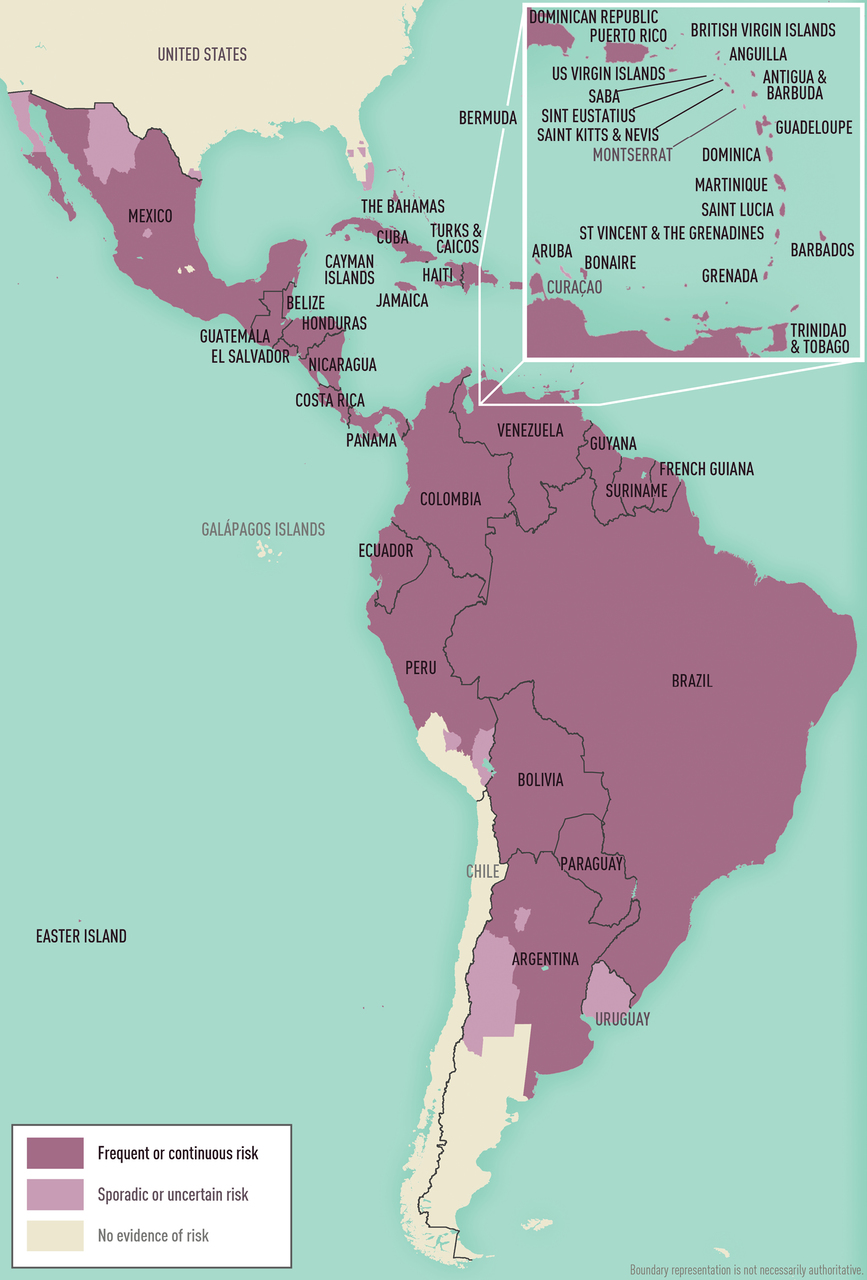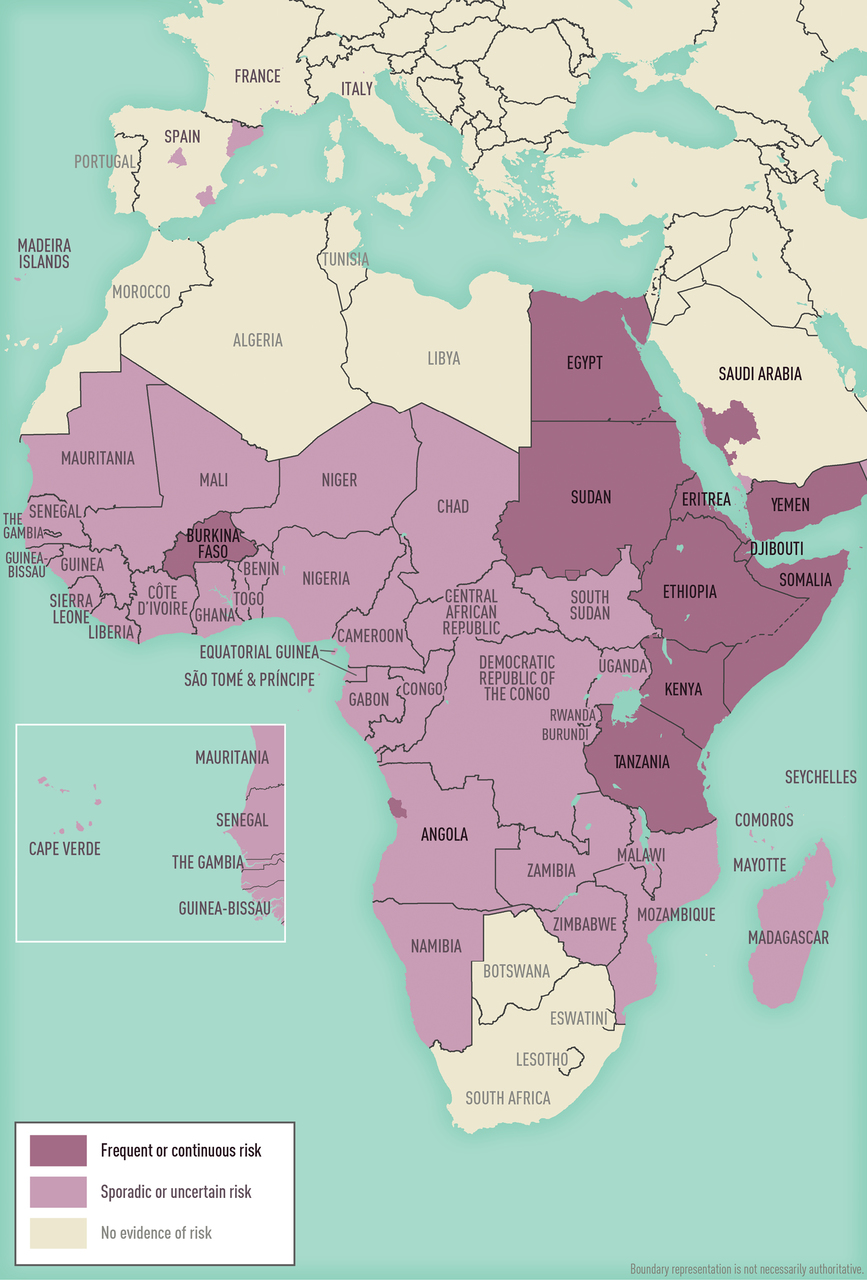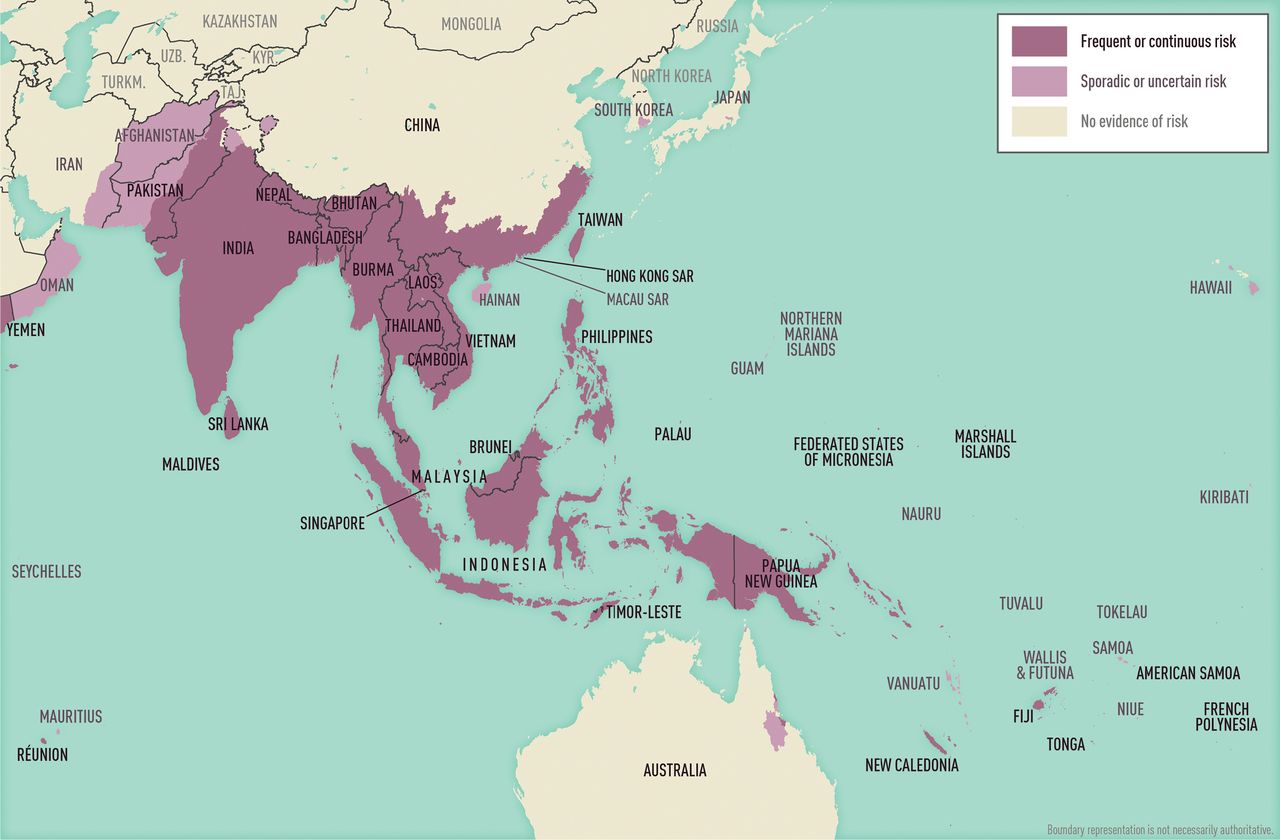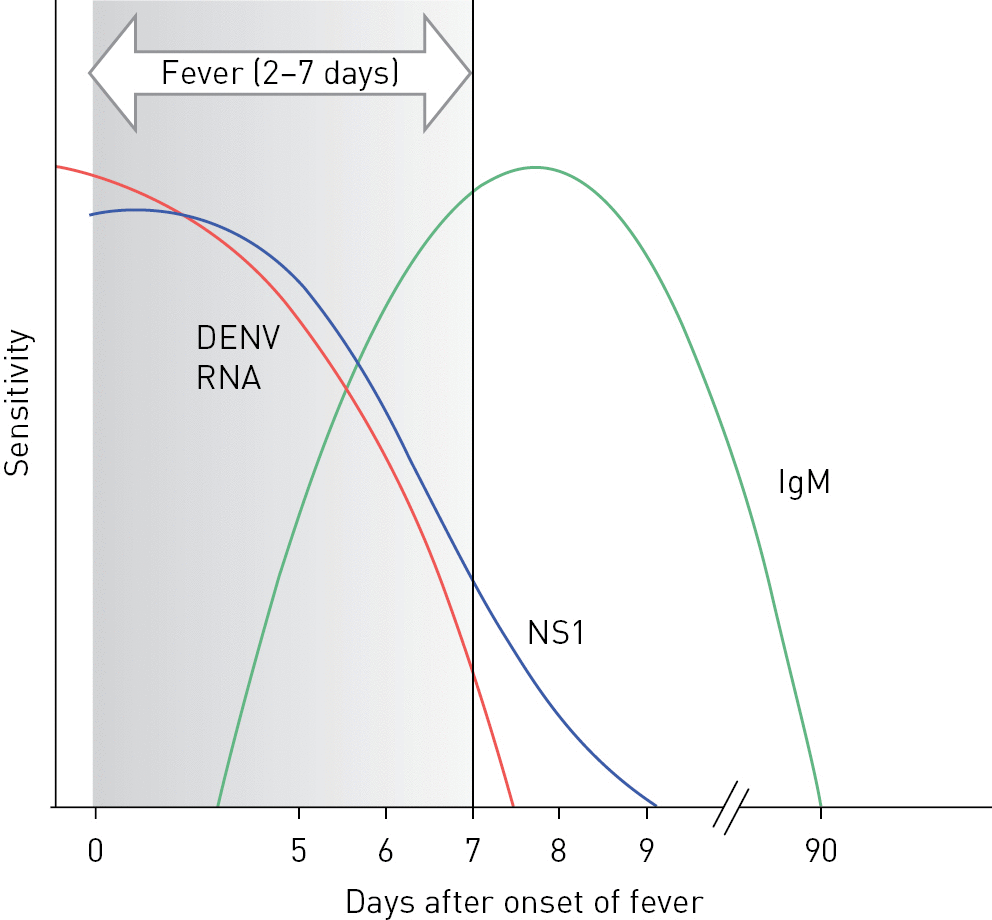Dengue
CDC Yellow Book 2024
Travel-Associated Infections & DiseasesINFECTIOUS AGENT: Dengue virus 1, 2, 3, 4
ENDEMICITY
Tropical and subtropical regions worldwide
TRAVELER CATEGORIES AT GREATEST RISK FOR EXPOSURE & INFECTION
PREVENTION METHODS
Avoid insect bites
Dengue is a vaccine-preventable disease (restrictions apply, see text for details)
DIAGNOSTIC SUPPORT
Infectious Agent
Dengue, an acute febrile illness, is caused by infection with any of 4 related single-stranded RNA viruses of the genus Flavivirus, dengue virus 1, 2, 3, or 4 (DENV1–4). Infection with one DENV confers long-term immunity to that virus but conveys only short-lived protection against the other dengue viruses. The risk for severe dengue is greater during a second DENV infection; although severe dengue also can occur during the first, third, or fourth infection.
Transmission
Almost all DENV transmission occurs through the bite of infected Aedes species mosquitoes, primarily Ae. aegypti and Ae. albopictus. Because of the ≈7-day viremia in humans, bloodborne transmission is possible through exposure to infected blood, organs, or other tissues (e.g., bone marrow). In addition, perinatal DENV transmission occurs when the mother is infected near the time of birth; infection occurs via microtransfusions as the placenta detaches, or through mucosal contact with maternal blood during birth. No cases of congenital transmission have been documented, but it has been suggested. DENV can be transmitted through breast milk. DENV also has been detected in vaginal secretions and semen; sexual transmission has been reported but is considered rare.
Epidemiology
Dengue is endemic throughout the tropics and subtropics and occurs in >100 countries and destinations worldwide, including Puerto Rico, the US Virgin Islands, and US–affiliated Pacific Islands (Map 5-03, Map 5-04, and Map 5-05). The incidence of dengue among travelers to the tropics has increased in recent years, and dengue burden is expected to continue to grow in sub-Saharan Africa, Latin America, and Asia, with estimates of >50 million febrile illness cases per year.
More than 5,000 travel-related dengue cases were reported in the United States during 2010–2017, with an annual average of 626 cases; a total of 2,119 patients with travel-related dengue required hospitalization, and 18 died. The most frequently reported regions of travel among US cases were the Caribbean, Central America, and Asia. Sporadic outbreaks with local transmission have occurred in Florida, Hawaii, and Texas. Although the geographic distribution of dengue is similar to that of malaria, dengue is more of a risk in urban and residential areas than is malaria.
Map 5-03 Dengue risk in the Americas & the Caribbean

Risk classification uses the methodology described in Jentes, et al. Evidence-based risk assessment and communication: a new global dengue-risk map for travellers and clinicians (www.ncbi.nlm.nih.gov/pmc/articles/PMC5345513/). Frequent/continuous risk: evidence of more than 10 dengue cases in at least 3 of the previous 10 years; sporadic/uncertain risk: evidence of at least 1 locally acquired dengue case during the last 10 years. Level of risk assigned to a destination reflects the highest risk level identified within that destination. Where data are available, subnational dengue risk levels are shown. Destination risk levels also are denoted using black (frequent/continuous risk) or gray (sporadic/uncertain risk) font for the place name.
Map 5-04 Dengue risk in Africa, Europe, & the Middle East
Risk classification uses the methodology described in Jentes, et al. Evidence-based risk assessment and communication: a new global dengue-risk map for travellers and clinicians (www.ncbi.nlm.nih.gov/pmc/articles/PMC5345513/). Frequent/continuous risk: evidence of more than 10 dengue cases in at least 3 of the previous 10 years; sporadic/uncertain risk: evidence of at least 1 locally acquired dengue case during the last 10 years. Level of risk assigned to a destination reflects the highest risk level identified within that destination. Where data are available, subnational dengue risk levels are shown. Destination risk levels also are denoted using black (frequent/continuous risk) or gray (sporadic/uncertain risk) font for the place name.
Map 5-05 Dengue risk in Asia & Oceania
Risk classification uses the methodology described in Jentes, et al. Evidence-based risk assessment and communication: a new global dengue-risk map for travellers and clinicians (www.ncbi.nlm.nih.gov/pmc/articles/PMC5345513/). Frequent/continuous risk: evidence of more than 10 dengue cases in at least 3 of the previous 10 years; sporadic/uncertain risk: evidence of at least 1 locally acquired dengue case during the last 10 years. Level of risk assigned to a destination reflects the highest risk level identified within that destination. Where data are available, subnational dengue risk levels are shown. Destination risk levels also are denoted using black (frequent/continuous risk) or gray (sporadic/uncertain risk) font for the place name.
Clinical Presentation
An estimated 40%–80% of DENV infections are asymptomatic. Symptomatic dengue most commonly presents as a mild to moderate, nonspecific, acute febrile illness; ≤5% of all dengue patients develop severe, life-threatening disease. Early clinical findings are nonspecific but require a high index of suspicion; recognizing early signs of shock and promptly initiating intensive supportive therapy can reduce risk for death among patients with severe dengue by ≥20-fold. See Table 5-09 for information regarding the World Health Organization guidelines for classifying dengue.
Table 5-09 Dengue Clinical Classification
Dengue
Dengue with Warning Signs
Severe Dengue
Dengue
Probable Dengue
Live in/travel to endemic area.
Fever and 2 of the following criteria
- Nausea/vomiting
- Rash
- Aches and pains
- Tourniquet test positive
- Leukopenia
- Any warning sign
Laboratory-confirmed dengue
- Molecular techniques/ IgM or IgG seroconversion
Dengue with Warning Signs
Presence of warning signs
- Abdominal pain or tenderness
- Persistent vomiting
- Clinical fluid accumulation (ascites, pleural effusion)
- Mucosal bleeding
- Lethargy, restlessness
- Postural hypotension
- Liver enlargement >2 cm
- Progressive increase in hematocrit
Severe Dengue
One of the following manifestations
- Shock or respiratory distress due to severe plasma leakage
- Severe bleeding (based on evaluation by attending physician)
- Severe organ involvement (such as liver or heart)
Source: Dengue: Guidelines for Patient Care in the Region of the Americas. Washington, DC: Pan-American Health Organization (2016).
Phases of Symptomatic Dengue
Febrile Phase
Symptomatic dengue begins abruptly after an incubation period of 5–7 days (range 3–10 days) and has a 3-phase clinical course: febrile, critical, and convalescent. Fever typically lasts 2–7 days and can be biphasic. Other signs and symptoms include severe headache; retro-orbital pain; bone, joint, and muscle pain; macular or maculopapular rash; and minor hemorrhagic manifestations, including ecchymosis, epistaxis, bleeding gums, hematuria, petechiae, purpura, or a positive tourniquet test result. Some patients have an injected oropharynx and facial erythema in the first 24–48 hours after onset. Warning signs of progression to severe dengue occur in the late febrile phase around the time of defervescence (i.e., temperature <100.4°F [38°C]) and can include severe abdominal pain, difficulty breathing, extravascular fluid accumulation, progressive increase in hematocrit (hemoconcentration), postural hypotension, lethargy or restlessness, liver enlargement, mucosal bleeding, and persistent vomiting.
Critical Phase
The critical phase of dengue begins at defervescence and typically lasts 24–48 hours. Most patients improve clinically during this phase, but those with substantial plasma leak (resulting from marked increase in vascular permeability) progress to severe dengue. Patients with substantial plasma leak can develop ascites or pleural effusions, hemoconcentration, and hypoproteinemia. Physiologic compensatory mechanisms narrow the pulse pressure as diastolic blood pressure increases, initially maintaining adequate circulation; patients might appear well despite early signs of shock.
Once hypotension develops, however, systolic blood pressure rapidly declines, and irreversible shock and death can ensue despite resuscitation efforts. Especially in cases of prolonged shock, patients can develop severe hemorrhagic manifestations, including hematemesis, melena, or menorrhagia. Uncommon manifestations during this phase include encephalitis, hepatitis, myocarditis, and pancreatitis. Laboratory findings commonly include elevated aspartate aminotransferase and alanine aminotransferase, hyponatremia, leukopenia, lymphopenia, thrombocytopenia, and a normal erythrocyte sedimentation rate.
Convalescent Phase
As plasma leakage subsides, patients enter the convalescent phase and well-being improves; extravasated intravenous fluids and abdominal and pleural effusions are reabsorbed, hemodynamic status stabilizes (although bradycardia could manifest), and diuresis ensues. The patient’s hematocrit stabilizes (or falls because of the dilutional effect of the reabsorbed fluid), and the white cell count usually starts to rise, after which the platelet count recovers. The convalescent phase rash might desquamate and be pruritic.
Dengue in Pregnancy
Data are limited on health outcomes of dengue in pregnancy and effects of maternal infection on the developing fetus. Perinatal transmission can occur, and peripartum maternal infection can increase the likelihood of symptomatic infection in the newborn. Signs and symptoms in perinatally infected neonates typically present during the first week of life and include ascites or pleural effusions, fever, hemorrhagic manifestations, hypotension, and thrombocytopenia. Placental transfer of maternal IgG against DENV from a previous maternal infection might increase risk for severe dengue among infants infected at 6–12 months of age when the protective effect of antibodies wanes.
Diagnosis
Dengue is a nationally notifiable disease in the United States; report all suspected cases to the state or local health department. Consider dengue in the differential diagnosis of patients who develop onset of symptoms ≤2 weeks after returning from an endemic area. For patients presenting ≤7 days after fever onset, diagnostic testing should include a nucleic acid amplification test for DENV and IgM (Figure 5-01). For patients presenting >7 days after fever onset, IgM testing is recommended. In the United States, both IgM ELISA and real-time reverse transcription PCR (RT-PCR) are approved as in vitro diagnostic tests.
Presence of virus by RT-PCR or DENV nonstructural protein 1 (NS1) antigen in a single diagnostic specimen is considered laboratory confirmation of dengue in patients with a compatible clinical and travel history. IgM in a single serum sample suggests a probable recent dengue infection. If a patient’s travel history includes locations where other potentially cross-reactive flaviviruses circulate, perform both molecular and serologic diagnostic testing to detect DENV and other flaviviruses.
ELISA IgG in a single serum sample is not useful for routine diagnostic testing because IgG remains detectable for life after infection. In addition, people infected with or vaccinated against other flaviviruses (e.g., Japanese encephalitis, yellow fever) might produce cross-reactive flavivirus antibodies, yielding false-positive serologic dengue diagnostic test results.
Molecular and serologic DENV diagnostic testing are available from several commercial reference diagnostic laboratories, state public health laboratories, and the Centers for Disease Control and Prevention (CDC)’s Dengue Branch. Clinicians can obtain consultation on dengue diagnostic testing from CDC at 787-706-2399 or by emailing dengue@cdc.gov.
Figure 5-01 Relative sensitivity of detection of dengue virus nucleic acid, antigen, and IgM
Abbreviations: DENV, dengue virus; NS1, nonstructural protein 1
DENV RNA and NS1 are detectable during the first week of illness. DENV IgM is detectable starting ≈5 days after illness onset. Although most cases only have detectable DENV IgM for 14–20 days after illness onset, in some cases IgM might be detectable for up to 90 days. Routine testing of DENV IgG with a single sample is not useful in identifying patients with dengue.
Treatment
No specific antiviral agents exist for dengue. Depending on the clinical manifestations, patients might need only ambulatory care or might require hospitalization. Advise ambulatory patients to stay well hydrated and to avoid medications with anticoagulant properties, including aspirin (acetylsalicylic acid), aspirin-containing drugs, and other nonsteroidal anti-inflammatory drugs (e.g., ibuprofen). To control fever, advise patients to use acetaminophen and tepid sponge baths. Caution febrile patients to avoid mosquito bites to reduce risk for further community transmission.
Patients who develop severe dengue require hospitalization and close observation; monitoring in an intensive care unit might be required. Intravenous fluid therapy is the mainstay of treatment when plasma leakage is recognized. Prophylactic platelet transfusions in dengue patients are not beneficial and can contribute to fluid overload. Similarly, administration of corticosteroids has no demonstrated benefit and is potentially harmful. Avoid use of corticosteroids except in cases of autoimmune-related complications. CDC has additional dengue case management recommendations [PDF].
Prevention
In June 2021, the Advisory Committee on Immunization Practices (ACIP) recommended Dengvaxia for children aged 9–16 years with laboratory-confirmed previous dengue infection who are living in areas of the United States where dengue is endemic. These areas include the US territories of American Samoa, Puerto Rico, and the US Virgin Islands, and freely associated states including the Federated States of Micronesia, the Republic of Marshall Islands, and the Republic of Palau.
Dengvaxia is not approved for use in US travelers who are visiting but not living in areas where dengue is endemic. In people who have not already been infected with DENV, Dengvaxia can increase the risk for severe illness and hospitalization if the person gets dengue after vaccination. Serodiagnostic tests with acceptable performance (≥75% sensitivity and ≥98% specificity) recommended by health authorities are available to test people for evidence of previous dengue. Only people who test positive for previous DENV infection or who have other laboratory-confirmed evidence of a previous DENV infection are eligible for vaccination with Dengvaxia. Two other dengue vaccines are currently undergoing phase 3 clinical trials.
No specific medication is available to prevent dengue. Risk increases with duration of travel and disease incidence in the travel destination (e.g., during local epidemics or the rainy season). Travelers going to the tropics for any length of time should take steps to prevent mosquito bites by using the preventive measures listed below and in Sec. 4, Ch. 6, Mosquitoes, Ticks & Other Arthropods.
- Select accommodations with well-screened windows and doors or air conditioning, when possible. Aedes mosquitoes typically live indoors and often are found in dark, cool places (e.g., in closets, under beds, behind curtains, in bathrooms, on porches).
- Wear clothing that covers the arms and legs, especially during the early morning and late afternoon, when risk of being bitten by Aedes species mosquitoes is greatest.
- Use insect repellent.
- For longer-term travelers, empty and clean or cover any standing water that can be a mosquito-breeding site in the local residence (e.g., water storage tanks, flowerpots).
CDC website: Dengue
The following authors contributed to the previous version of this chapter: Tyler M. Sharp, Janice Perez-Padilla, Stephen H. Waterman


